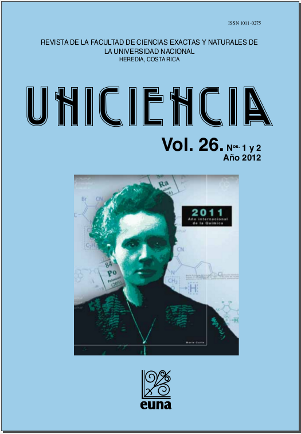Antibacterial activity of the marine sponge Ircinia Campana collected at Punta Uva Limón against Staphylococcus Aureus
Keywords:
Antibiotic activity, sponge, biological activity, bioactive extractsAbstract
The sponges are simple multicellularorganisms; they inhabit in marine environments from the polar seas to the tropical waterswhere they are more abundant. These species are exposed to large populations of microbes, reason that explains their complex morphological and cellular defense mechanism, which are used by these organisms to fight against pathogens. The purpose of this study was to evaluate the antibacterial activity of the marine sponge Ircinia campana, whichinhabits in the south of the Caribbean coast of Costa Rica against Sthapylococcus aureus gram-positive bacteria. Sampleswere collected in Punta Uva in Limónduring July of 2007. The active compounds were obtainedby extraction with acetone (crude extract); and subsequently, chromatographic extracts were obtained using fractions 1:4 hexane: ethyl acetate. The antibacterial activities of the different fractions, including the crude extract were tested.Our results suggest a zone of inhibition of 14.60 ±0.25 mm for the crude extract and18.70±0.25mm for the most active fraction separated by chromatography. The metabolite responsible for the antibacterial activity was isolated by High Performance Liquid Chromatography (HPLC)and preliminarily characterized through ultraviolet (UV) and infrared (IR) spectroscopy.Downloads
Published
Issue
Section
License
Authors who publish with this journal agree to the following terms:
1. Authors guarantee the journal the right to be the first publication of the work as licensed under a Creative Commons Attribution License that allows others to share the work with an acknowledgment of the work's authorship and initial publication in this journal.
2. Authors can set separate additional agreements for non-exclusive distribution of the version of the work published in the journal (eg, place it in an institutional repository or publish it in a book), with an acknowledgment of its initial publication in this journal.
3. The authors have declared to hold all permissions to use the resources they provided in the paper (images, tables, among others) and assume full responsibility for damages to third parties.
4. The opinions expressed in the paper are the exclusive responsibility of the authors and do not necessarily represent the opinion of the editors or the Universidad Nacional.
Uniciencia Journal and all its productions are under Creative Commons Atribución-NoComercial-SinDerivadas 4.0 Unported.
There is neither fee for access nor Article Processing Charge (APC)






